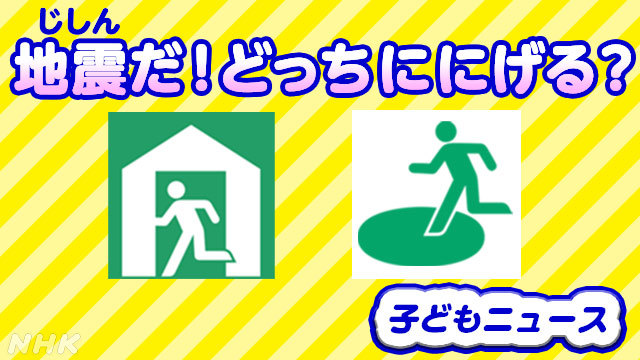do you know this
Symbols representing disasters NHK Children's News March 10, 11:04
Earthquakes, tsunamis, typhoons, volcanic eruptions...
Japan is a country with many disasters.
There are many types of disasters.
When you are at school, playing with your friends after school, or traveling with your family, you never know when and where a disaster will strike.
In the unlikely event that a disaster occurs, there are “symbols” that will tell you where to escape.
how much do you know
Do you know this symbol?
Well, it's a sudden, but it's a quiz.
"Evacuation sites" are often large open spaces outside, such as large parks and parking lots.
Second question.
It's similar to the previous problem, but...
While "evacuation sites" are places where people can escape when the danger of a disaster is imminent, "evacuation centers" are places where people who can no longer live in their homes can live for a while after the danger of a disaster has passed. It's a place where you can
There are places where evacuation sites and shelters are combined.
By the way, here is the "emergency exit" sign that means "please get out of here" in the event of a fire, earthquake, or other dangerous situation in the building.
I think it's also in the school, but it's very similar.
Why are the symbols different even though they are similar?
Why are "evacuation sites" and "refuges" represented by different symbols?
The reason for this is the Great East Japan Earthquake that occurred on March 11, 2011.
Click here for the video of the Great East Japan Earthquake
(*This video contains images of violent shaking and tsunami.)
At 2:46 p.m., a large earthquake struck, sending a tsunami more than 10 meters high along the Tohoku and Kanto coasts, killing over 18,000 people and leaving them missing. I'm here.
In the Great East Japan Earthquake, people who evacuated died there.
The government changed the law, believing that one of the reasons why the damage was so great was that there was no distinction between "evacuation sites" and "evacuation centers."
As a result, the leaders of municipalities decided in advance to separate "evacuation sites" and "evacuation centers" and taught them to the residents.
Preparing for Tsunamis
Next, question 3.
There is a danger of a tsunami, but there is no high ground around, or you are in a flat place and cannot escape to high ground.
We are also preparing for such cases.
It is a building called Tsunami Evacuation Building or Tsunami Evacuation Tower.
Tsunami evacuation buildings are selected by municipalities from among buildings that comply with rules such as height and strength.
There are 15,000 tsunami evacuation buildings nationwide, eight times the number before the Great East Japan Earthquake.
(As of April 2021)
Click here for symbols representing these tsunami evacuation buildings and tsunami evacuation towers.
People who live near the sea may see it often.
However, even if you don't live near the sea, there is a risk that a tsunami will occur when you travel.
Just in case, please remember.
Symbols representing types of disasters
There are also symbols for different types of disasters.
1. Flood
2. Debris flow
3. Large fire
4. Tsunami and storm surge
5. Cliff collapse/landslide
This symbol is sometimes used to convey "evacuation site" or "evacuation center".
This is to teach people with symbols what kind of disasters they should run to.
This is the symbol actually displayed at Tama Daiichi Elementary School in Tama City, Tokyo.
There is a circle next to the fire symbol.
However, "Cliff failure/landslide", "Debris flow" and "Flood" are marked with an X.
In other words, you can see that it is a place to escape in case of fire, not a place to escape in case of heavy rain.
Quiz
Well, one last quiz.
Did you understand what the symbols mean in this article?
But even if you know what the symbols mean, if you don't know where they are, you'll be at a loss as to where to escape if a disaster strikes.
Please look for this symbol near your home or school on your days off.
If you can find it, tell your family, friends, and people around you to prepare for disasters.
Check out this video about evacuating from a tsunami.
NHK for School

